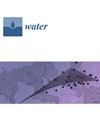硅砂透水砖的特性及其在雨水处理中的性能
IF 3
3区 环境科学与生态学
Q2 ENVIRONMENTAL SCIENCES
引用次数: 0
摘要
城市化进程的加快破坏了自然水循环,导致城市不透水地面增加,雨水径流造成非点源污染。解决城市雨水补给问题变得至关重要。本研究介绍了一种新型硅砂基透水过滤材料,对其表面特征、孔隙结构、渗透性和污染物拦截能力进行了研究。结果表明,亲水粘合剂涂层改性的透水性表面砂骨料,结合亲水无机添加剂,具有平均孔径小于 50 μm、孔隙率介于 15% 至 35% 之间的多孔结构,可显著增强表面亲水性,使渗透率高达 6.8 mL/(min-cm²)。此外,它还具有优异的过滤和防堵塞性能,悬浮固体拦截率超过 98%,并具有很强的防堵塞能力。利用模拟雨水和生活废水进行的动态生物膜形成实验探索了硅砂过滤井表面的生物膜形态和功能。成熟的生物膜对 COD 的去除率超过 70%,浓度始终低于 50 mg/L,NH4+ 降低到 2 mg N/L,总氮保持在 10 mg N/L 以下。该系统设有缺氧区、缺氧区和好氧区,可促进多种微生物协同去除有机物和氮,从而提高污染物缓解能力。以硅砂为基础的可渗透过滤材料可有效缓解城市雨水径流污染物--悬浮固体、有机物和氮--为海绵城市建设和雨水资源管理提供了创新解决方案。本文章由计算机程序翻译,如有差异,请以英文原文为准。
Characterization of Silica Sand-Based Pervious Bricks and Their Performance under Stormwater Treatment
The acceleration of urbanization has disrupted natural water cycles, resulting in increased impervious urban surfaces and non-point source pollution from stormwater runoff. Addressing urban stormwater recharge has become crucial. This study introduces a novel silica sand-based permeable filtration material, investigating its surface characteristics, pore structure, permeability, and pollutant interception capabilities. The results demonstrate that hydrophilic binder coating modification of the permeable surface sand aggregate, combined with hydrophilic inorganic additives, having a porous structure with an average pore size of less than 50 μm and a porosity between 15% and 35%, significantly enhances surface hydrophilicity, achieving a permeation rate of up to 6.8 mL/(min·cm²). Moreover, it shows exceptional filtration and anti-clogging properties, achieving over 98% suspended solids interception and strong resistance to fouling. Dynamic biofilm formation experiments using simulated rain and domestic wastewater explore biofilm morphology and function on silica sand filtration well surfaces. Mature biofilms sustain COD removal efficiency exceeding 70%, with levels consistently below 50 mg/L, NH4+ decreasing to 2 mg N/L, and total nitrogen maintained below 10 mg N/L. The system features anoxic, anoxic, and aerobic zones, fostering synergistic organic matter and nitrogen removal by diverse microorganisms, enhancing pollutant mitigation. Silica sand-based permeable filtration material effectively mitigates urban stormwater runoff pollutants—suspended solids, organic matter, and nitrogen—offering an innovative solution for sponge city development and rainwater resource management.
求助全文
通过发布文献求助,成功后即可免费获取论文全文。
去求助
来源期刊

Water
WATER RESOURCES-
CiteScore
5.80
自引率
14.70%
发文量
3491
审稿时长
19.85 days
期刊介绍:
Water (ISSN 2073-4441) is an international and cross-disciplinary scholarly journal covering all aspects of water including water science and technology, and the hydrology, ecology and management of water resources. It publishes regular research papers, critical reviews and short communications, and there is no restriction on the length of the papers. Our aim is to encourage scientists to publish their experimental and theoretical research in as much detail as possible. Full experimental and/or methodical details must be provided for research articles. Computed data or files regarding the full details of the experimental procedure, if unable to be published in a normal way, can be deposited as supplementary material.
 求助内容:
求助内容: 应助结果提醒方式:
应助结果提醒方式:


